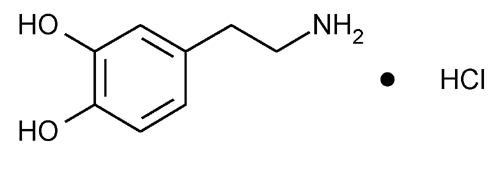Dopamine Hydrochloride
1,2-Benzenediol, 4-(2-aminoethyl)-, hydrochloride.
4-(2-Aminoethyl)pyrocatechol hydrochloride
» Dopamine Hydrochloride contains not less than 98.0 percent and not more than 102.0 percent of C8H11NO2·HCl, calculated on the dried basis.
Packaging and storage—
Preserve in tight containers. Store at room temperature.
Clarity and color of solution—
A solution of 400 mg in 10 mL of sodium bisulfite solution (1 in 1000) is clear and colorless or practically colorless.
Identification—
B: Ultraviolet Absorption  197U
197U —
—
Solution:
40 µg per mL.
Medium:
sodium bisulfite in water (1 in 1000).
C:
It responds to the tests for Chloride  191
191 .
.
pH  791
791 :
between 3.0 and 5.5, in a solution (1 in 25).
:
between 3.0 and 5.5, in a solution (1 in 25).
Loss on drying  731
731 —
Dry it at 105
—
Dry it at 105 for 2 hours: it loses not more than 0.5% of its weight.
for 2 hours: it loses not more than 0.5% of its weight.
Residue on ignition  281
281 :
not more than 0.1%.
:
not more than 0.1%.
Heavy metals, Method I  231
231 —
Dissolve 1 g in 25 mL of water: the limit is 0.002%.
—
Dissolve 1 g in 25 mL of water: the limit is 0.002%.
Sulfate  221
221 —
Dissolve 500 mg in 40 mL of water: any turbidity produced is not more than that produced in a solution containing 0.10 mL of 0.020 N sulfuric acid.
—
Dissolve 500 mg in 40 mL of water: any turbidity produced is not more than that produced in a solution containing 0.10 mL of 0.020 N sulfuric acid.
Readily carbonizable substances  271
271 —
Dissolve 100 mg in 5 mL of sulfuric acid TS: the solution has no more color than Matching Fluid A.
—
Dissolve 100 mg in 5 mL of sulfuric acid TS: the solution has no more color than Matching Fluid A.
Chromatographic purity—
Standard solution and Standard dilutions—
Prepare a solution of USP Dopamine Hydrochloride RS in methanol to contain 30 mg per mL (Standard solution). Prepare a series of dilutions of the Standard solution in methanol to contain 0.6 mg, 0.3 mg, and 0.15 mg per mL (Standard dilutions), corresponding to 2.0%, 1.0%, and 0.5% of impurities, respectively.
Test solution—
Transfer 150 mg of Dopamine Hydrochloride to a 5-mL volumetric flask, dilute with methanol to volume, and mix.
Procedure—
In a suitable chromatographic chamber arranged for thin-layer chromatography (see Chromatography  621
621 ), place a solvent system consisting of 13 volumes of chloroform, 9 volumes of methanol, and 4 volumes of dilute glacial acetic acid (3 in 10). Line the chamber with filter paper, and allow to equilibrate. Apply 10-µL portions of the Standard solution, the Standard dilutions, and the Test solution to a 20- × 20-cm chromatographic plate coated with a 0.25-mm layer of chromatographic silica gel mixture. Develop the chromatogram until the solvent front has moved about 15 cm. Remove the plate from the developing chamber, allow to dry at room temperature for several minutes, and spray evenly with a freshly prepared mixture containing equal volumes of ferric chloride solution (1 in 10) and potassium ferricyanide solution (1 in 20). [Dopamine and its related impurities appear as blue spots under visible light.] The Test solution exhibits its principal spot at an RF value corresponding to that of the Standard solution and not more than three secondary spots. Estimate the concentration of any secondary spots exhibited by the Test solution by comparison with the Standard dilutions: the sum of the impurities is not greater than 1.0%.
), place a solvent system consisting of 13 volumes of chloroform, 9 volumes of methanol, and 4 volumes of dilute glacial acetic acid (3 in 10). Line the chamber with filter paper, and allow to equilibrate. Apply 10-µL portions of the Standard solution, the Standard dilutions, and the Test solution to a 20- × 20-cm chromatographic plate coated with a 0.25-mm layer of chromatographic silica gel mixture. Develop the chromatogram until the solvent front has moved about 15 cm. Remove the plate from the developing chamber, allow to dry at room temperature for several minutes, and spray evenly with a freshly prepared mixture containing equal volumes of ferric chloride solution (1 in 10) and potassium ferricyanide solution (1 in 20). [Dopamine and its related impurities appear as blue spots under visible light.] The Test solution exhibits its principal spot at an RF value corresponding to that of the Standard solution and not more than three secondary spots. Estimate the concentration of any secondary spots exhibited by the Test solution by comparison with the Standard dilutions: the sum of the impurities is not greater than 1.0%.
Assay—
Dissolve about 75 mg of Dopamine Hydrochloride, accurately weighed, in 5 mL of formic acid, add 25 mL of acetic anhydride, and mix. Titrate with 0.1 N perchloric acid VS, determining the endpoint potentiometrically. Perform a blank determination, and make any necessary correction. Each mL of 0.1 N perchloric acid is equivalent to 18.96 mg of C8H11NO2·HCl.
Auxiliary Information—
Please check for your question in the FAQs before contacting USP.
| Topic/Question | Contact | Expert Committee |
| Monograph | Sujatha Ramakrishna, Ph.D.
Scientist 1-301-816-8349 |
(MDCV05) Monograph Development-Cardiovascular |
| Reference Standards | Lili Wang, Technical Services Scientist 1-301-816-8129 RSTech@usp.org |
USP32–NF27 Page 2201
Pharmacopeial Forum: Volume No. 34(5) Page 1152
